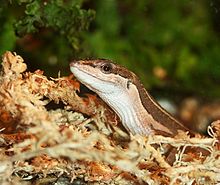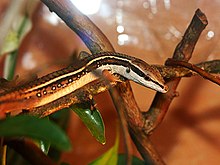Six-lined long-tailed lizard
| Six-lined long-tailed lizard | ||||||||||||
|---|---|---|---|---|---|---|---|---|---|---|---|---|

male six-lined long-tailed lizard ( Takydromus sexlineatus ocellatus ) |
||||||||||||
| Systematics | ||||||||||||
|
||||||||||||
| Scientific name | ||||||||||||
| Takydromus sexlineatus | ||||||||||||
| Daudin , 1802 |
The takydromus sexlineatus ( Takydromus sexlineatus ) is an animal art from the genus of the fast-running lizards ( Takydromus ). It is a typical representative of the real lizards (Lacertidae). The species is easy to recognize by its disproportionately long tail, which takes up about 5/6 of the total length, and by the lively black and white vertical stripes in the male sex.
features
Adult Takydromus sexlineatus have a head-torso length (KRL) of about eight centimeters, but thanks to the extremely long tail that gives them their name, they reach a total length (GL) of over 30 centimeters.
The species is typically very slender, the head is small, significantly longer than it is wide and, typically for lizards, only slightly separated from the body.
Male animals have two hemipenes in the cloacal region , which are turned out for mating. These organs, which are located in their own skin pockets (hemipenis pockets), make the tail root appear thickened.
The large feet and long tail serve to distribute weight and stabilize and enable the animals to climb even very thin blades of grass in their habitat without kinking them. The animals can also get up on their hind legs by supporting their tails and cope with high jumps from this position.
The coloring is made up of vividly contrasting white, brown and black tones, with the males often having a more intense and contrasting color scheme. Some populations show light green flanks. Males of the subspecies T. s. ocellatus also have white ocellus spots on the flanks, which the females lack. With the nominate form T. s. sexlineatus , this characteristic is not or only very weakly developed.
The species is able to repel its tail in danger ( autotomy ). The missing organ grows back and does not affect the animal's health very much.
Occurrence and way of life
The six-lined long-tailed lizard has a very large distribution area in South and Southeast Asia , stretching from India through southern China , Burma and Thailand to the Malay Peninsula and even Indonesia . The species is typically found on high meadows and in sparse forests, where it mainly inhabits the lower herbaceous layer.
Takydromus sexlineatus is a very nimble diurnal hunter who mainly feeds on small insects. Prey animals are captured with a rapid forward movement of the entire body and swallowed whole. The small lizards can also consume prey of considerable size. After the meal, the little hunter cleans his mouth by licking it extensively with his long, flexible tongue.
The intraspecific territorial behavior is usually only weak in both sexes.
Reproduction
Little is known about the reproduction of this species in the field; most of the findings are based on observations in terrarium keeping . The willingness to mate is shown here especially after a cooler and drier period, after which the humidity is increased by frequent spraying. The male initiates mating by biting the female's flank or pelvic region; copulation itself only takes about two minutes. The females produce four to six clutches per year, which are laid at intervals of two to six weeks. A clutch consists of two to three (in T. s. Ocellatus two to five) eggs, which are laid in protected areas or buried in the warm, humid substrate. The approximately seven to eight centimeters (GL) long young animals hatch at temperatures around 25 ° C after 40 to 50 days. They have reddish tail tips and resemble adult females in the rest of the color. Male T. sexlineatus often show a pronounced sex drive and intensely chase after females ready to mate.
Takydromus sexlineatus is considered easy to breed if the correct husbandry parameters are adhered to.
Systematics
Takydromus sexlineatus is due to its morphological and osteological characteristics as the most modern representative of the high-speed lizards . The relationship and development relationships of T. sexlineatus within the genus can be determined using a cladogram according to Arnold 1977 and Chou et al. 2001 represent:
| Platyplacopus | |||||||||||||||||||||||||||||||||||||
| Takydromus | |||||||||||||||||||||||||||||||||||||
| T. amurensis | |||||||||||||||||||||||||||||||||||||
| Takydromus | |||||||||||||||||||||||||||||||||||||
| T. tachydromoides | |||||||||||||||||||||||||||||||||||||
| T. wolteri | |||||||||||||||||||||||||||||||||||||
| T. hsuehshanensis | |||||||||||||||||||||||||||||||||||||
| T. formosanus | |||||||||||||||||||||||||||||||||||||
| T. septentrionalis | |||||||||||||||||||||||||||||||||||||
| T. khasiensis | |||||||||||||||||||||||||||||||||||||
| T. sexlineatus sexlineatus | |||||||||||||||||||||||||||||||||||||
| T. sexlineatus | |||||||||||||||||||||||||||||||||||||
| T. sexlineatus ocellatus | |||||||||||||||||||||||||||||||||||||
Subspecies
- Takydromus sexlineatus sexlineatus (Daudin, 1802)
- Occurrence: NE India , Myanmar to Indonesia in evergreen rainforests.
- 4 longitudinal rows of back scales between the forelimbs
- 10 vertical rows of scales on the underside
- smooth top of the head
- 1-2 femoral pores per side
- Flanks without drawing
According to
- Takydromus sexlineatus ocellatus (Cuvier, 1829)
- Occurrence: South China , Laos , Vietnam , Cambodia in rain-green wet forests and humid grass savannas.
- 6 longitudinal rows of back scales between the forelimbs
- 10–14 vertical rows of scales on the underside
- rough top of the head
- 1 femoral pore per side
- Flanks in the male sex with ocellus drawing
According to
There is uncertainty about the exact distribution area of the recognized subspecies and its limits. There are indications of a sympatric occurrence of the subspecies in Vietnam , which suggests that T. s. ocellatus could indicate.
literature
- Uwe Schlüter: The long-tailed lizards of the genus Takydromus. Care, breeding and way of life. Kirschner and Seufer, Keltern-Weiler 2003, ISBN 3-9804207-6-0 .
Web links
- Takydromus sexlineatus at DahmsTierleben
- Takydromus sexlineatus in The Reptile Database
- Takydromus sexlineatus inthe IUCN Red List of Threatened Species 2013.2. Posted by: Auliya, M., 2009. Retrieved January 30, 2014.


